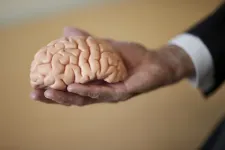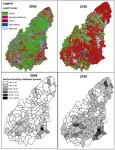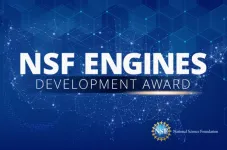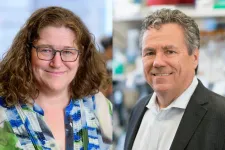(Press-News.org) Could changing your diet play a role in slowing or even preventing the development of dementia? We’re one step closer to finding out, thanks to a new UNLV study that bolsters the long-suspected link between gut health and Alzheimer’s disease.
The analysis — led by a team of researchers with the Nevada Institute of Personalized Medicine (NIPM) at UNLV and published this spring in the Nature journal Scientific Reports — examined data from dozens of past studies into the belly-brain connection. The results? There’s a strong link between particular kinds of gut bacteria and Alzheimer’s disease.
Between 500 and 1,000 species of bacteria exist in the human gut at any one time, and the amount and diversity of these microorganisms can be influenced by genetics and diet.
The UNLV team’s analysis found a significant correlation between 10 specific types of gut bacteria and the likelihood of developing Alzheimer’s disease. Six categories of bacteria — Adlercreutzia, Eubacterium nodatum group, Eisenbergiella, Eubacterium fissicatena group, Gordonibacter, and Prevotella9 — were identified as protective, and four types of bacteria — Collinsella, Bacteroides, Lachnospira, and Veillonella — were identified as a risk factor for Alzheimer’s disease.
Certain bacteria in humans’ guts can secrete acids and toxins that thin and seep through the intestinal lining, interact with the APOE (a gene identified as a major risk factor for Alzheimer’s disease), and trigger a neuroinflammatory response — affecting brain health and numerous immune functions, and potentially promoting development of the neurodegenerative disorder.
Researchers said their novel discovery of the distinct bacterial groups associated with Alzheimer’s disease provides new insights into the relationship between gut microbiota and the world’s most common form of dementia. The findings also advance scientists’ understanding of how an imbalance of that bacteria may play a role in the disorder’s development.
“Most of the microorganisms in our intestines are considered good bacteria that promote health, but an imbalance of those bacteria can be toxic to a person’s immune system and linked to various diseases, such as depression, heart disease, cancer, and Alzheimer’s disease,” said UNLV research professor Jingchun Chen. “The take-home message here is that your genes not only determine whether you have a risk for a disease, but they can also influence the abundance of bacteria in your gut.”
While their analysis established overarching categories of bacteria typically associated with Alzheimer’s disease, the UNLV team said further research is needed to drill down into the specific bacterial species that influence risk or protection.
The hope is to one day develop treatments that are customized for an individual patient and their genetic makeup, such as medications or lifestyle change. Studies have shown that changes in gut microbiome through probiotic use and dietary adjustments can positively impact the immune system, inflammation, and even brain function.
“With more research it would be possible to identify a genetic trajectory that could point to a gut microbiome that would be more or less prone to developing diseases such as Alzheimer’s,” said study lead author and UNLV graduate student Davis Cammann, “but we also have to remember that the gut biome is influenced by many factors including lifestyle and diet.”
Publication Details
“Genetic correlations between Alzheimer’s disease and gut microbiome genera” was published this spring in Scientific Reports.
In addition to faculty, undergraduate, and graduate student researchers from NIPM, scientists from the UNLV College of Sciences, UNLV School of Dental Medicine, UNLV School of Integrated Health Sciences’ Department of Brain Health, Kirk Kerkorian School of Medicine at UNLV, Columbia University, and University of Texas Health Science Center at Houston contributed to the study.
END
Brain-belly connection: gut health may influence likelihood of developing Alzheimer’s
UNLV study pinpoints 10 bacterial groups associated with Alzheimer’s disease, provides new insights into the relationship between gut makeup and dementia
2023-05-11
ELSE PRESS RELEASES FROM THIS DATE:
New research from UMass Amherst links changes in land use to water quality and quantity
2023-05-11
AMHERST, Mass. – Researchers at the University of Massachusetts Amherst recently published a study in the journal PLOS Water that focuses on the Sudbury-Assabet and Concord watershed in eastern Massachusetts, and which links hydrological changes, including floods, drought and runoff, to changing patterns of land use.
“We all live in a watershed” says Timothy Randhir, professor of environmental conservation at UMass Amherst and the paper’s senior author. “We’re constantly modifying our landscape, turning what were once forests into ...
UC Irvine study shows traffic-related air pollution in Irvine weakens brain function
2023-05-11
Irvine, Calif., May 11, 2023 – Researchers from the University of California, Irvine have found that exposure to traffic-related air pollution in Irvine led to memory loss and cognitive decline and triggered neurological pathways associated with the onset of Alzheimer’s disease.
“The link between air pollution and Alzheimer’s disease is concerning, as the prevalence of toxicants in ambient air is not just on the rise globally, but also hitting close to home here in Irvine,” said corresponding ...
Bail reform law in New York had negligible effect on increases in crime
2023-05-11
Across the United States, legislators and the public have debated the issue of bail reform, which aims to reduce pretrial jail populations by eliminating cash bail. New York State passed legislation in 2019 to limit the use of money bail and expand pretrial release. In a new study, researchers evaluated the effect of the law on state crime rates, considering the effect of the COVID-19 pandemic. Although rates of murder, larceny, and motor vehicle theft rose after the bail reform law went into effect, none of the increases were statistically significant when compared with a control group. This suggests that the effect of bail reform on crime rate increases was negligible.
The study, ...
The science of attraction: why do we fall for certain people?
2023-05-11
Sometimes life’s most meaningful relationships grow from the briefest of connections. Like when you go to a party and meet someone wearing your favorite band’s T-shirt, or who laughs at the same jokes as you, or who grabs that unpopular snack you alone (or so you thought) love. One small, shared interest sparks a conversation—that’s my favorite, too!—and blossoms into lasting affection.
This is called the similarity-attraction effect: we generally like people who are like us. Now, new findings from a Boston ...
Estimated annual spending on Lecanemab and its ancillary costs in the Medicare program
2023-05-11
About The Study: Lecanemab and associated ancillary services could add an estimated $2 billion to $5 billion annually to Medicare spending with substantial out-of-pocket costs for beneficiaries lacking supplemental coverage, according to a cost analysis using nationally representative survey data. Lecanemab, an antidementia medication with modest clinical benefit, received accelerated Food and Drug Administration approval.
Authors: John N. Mafi, M.D., M.P.H., of the David Geffen School of Medicine at the University of California, Los Angeles, is the corresponding ...
Kentucky, Tennessee GAME Change team wins NSF Engines Development Award
2023-05-11
LEXINGTON, Ky. (May 11, 2023) — The University of Kentucky, as lead organization, together with partners across Kentucky and Tennessee, has been awarded $1 million from the U.S. National Science Foundation’s Regional Innovation Engines, or NSF Engines, program. This team’s proposal, “Advancing carbon centric circular economy technologies for advanced manufacturing solutions (KY, TN),” is led by a coalition named Generate Advanced Manufacturing Excellence for Change (GAME Change).
The GAME Change team is among the more than 40 unique teams to receive one of the first-ever NSF Engines ...
Study could help solve mystery of the disappearing twins
2023-05-11
Key takeaways
UCLA and Keck Observatory scientists analyzed over a decade’s worth of data about 16 young supermassive stars orbiting the supermassive black hole at the center of the Milky Way galaxy.
Supermassive stars typically are formed in pairs, but the new study found that all 16 of the stars were singletons.
The findings support a scenario in which the supermassive black hole drives nearby stars to either merge or be disrupted, with one of the pair being ejected from the system.
When supermassive stars are born, they’re almost always paired ...
Expansion of cell-to-cell communication drives the early development of pancreatic cancer, new research in mice finds
2023-05-11
Discussions of cancer often stress the genetic mutations that drive disease by altering the normal function of cellular proteins. KRAS, for example, normally acts as an on/off switch for cellular proliferation, but mutations to the gene — common in lung cancer, colorectal cancer and pancreatic cancer — cause that switch to stay on.
Yet mutations are only half of the story.
Interactions between these genetic mutations and external factors, such as tissue injury that leads to inflammation, reshape both cells’ identities and their local environment in ways that foster cancer’s emergence and runaway growth.
In pancreatic cancer, these changes start ...
When stem cells can’t roll on a bumpy road, muscles break down
2023-05-11
Key takeaways
Stem cells travel along a collagen network to reach damaged muscle tissue and heal it.
In Duchenne muscular dystrophy, stiff, scarred collagen prevents stem cells from reaching their target.
A protein called sarcospan lessens this scarring and allows stem cells to do their job more successfully, pointing toward potential new treatments for the disorder.
Muscles that ache after a hard workout usually don’t hurt for long, thanks to stem cells that rush to the injured site along “collagen highways” within the muscle and repair the damaged tissue. ...
SwRI to lead NASA/SSERVI Center for Lunar Origin and Evolution
2023-05-11
SAN ANTONIO — May 11, 2023 —Southwest Research Institute has entered into a five-year, $7.5-million cooperative agreement with NASA to lead the Center for Lunar Origin and Evolution (CLOE), which will conduct basic research to support science enabled by human exploration of the Moon and the Endurance-A mission concept, a far side lunar rover mission prioritized by the 2022 Planetary Science and Astrobiology Decadal Survey report, “Origins, Worlds, and Life.” CLOE will be part of NASA’s Solar System Exploration Research Virtual Institute (SSERVI).
“The Moon is unmatched in its potential to provide ...
LAST 30 PRESS RELEASES:
Making lighter work of calculating fluid and heat flow
Normalizing blood sugar can halve heart attack risk
Lowering blood sugar cuts heart attack risk in people with prediabetes
Study links genetic variants to risk of blinding eye disease in premature infants
Non-opioid ‘pain sponge’ therapy halts cartilage degeneration and relieves chronic pain
AI can pick up cultural values by mimicking how kids learn
China’s ecological redlines offer fast track to 30 x 30 global conservation goal
Invisible indoor threats: emerging household contaminants and their growing risks to human health
Adding antibody treatment to chemo boosts outcomes for children with rare cancer
Germline pathogenic variants among women without a history of breast cancer
Tanning beds triple melanoma risk, potentially causing broad DNA damage
Unique bond identified as key to viral infection speed
Indoor tanning makes youthful skin much older on a genetic level
Mouse model sheds new light on the causes and potential solutions to human GI problems linked to muscular dystrophy
The Journal of Nuclear Medicine ahead-of-print tip sheet: December 12, 2025
Smarter tools for peering into the microscopic world
Applications open for funding to conduct research in the Kinsey Institute archives
Global measure underestimates the severity of food insecurity
Child survivors of critical illness are missing out on timely follow up care
Risk-based vs annual breast cancer screening / the WISDOM randomized clinical trial
University of Toronto launches Electric Vehicle Innovation Ontario to accelerate advanced EV technologies and build Canada’s innovation advantage
Early relapse predicts poor outcomes in aggressive blood cancer
American College of Lifestyle Medicine applauds two CMS models aligned with lifestyle medicine practice and reimbursement
Clinical trial finds cannabis use not a barrier to quitting nicotine vaping
Supplemental nutrition assistance program policies and food insecurity
Switching immune cells to “night mode” could limit damage after a heart attack, study suggests
URI-based Global RIghts Project report spotlights continued troubling trends in worldwide inhumane treatment
Neutrophils are less aggressive at night, explaining why nighttime heart attacks cause less damage than daytime events
Menopausal hormone therapy may not pose breast cancer risk for women with BRCA mutations
Mobile health tool may improve quality of life for adolescent and young adult breast cancer survivors
[Press-News.org] Brain-belly connection: gut health may influence likelihood of developing Alzheimer’sUNLV study pinpoints 10 bacterial groups associated with Alzheimer’s disease, provides new insights into the relationship between gut makeup and dementia





